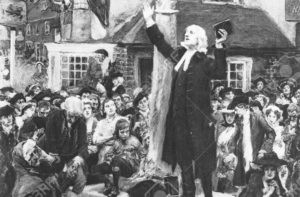While the Southern Baptist Convention — the nation’s largest non-Catholic denomination — has been in the news lately for removing churches from its fellowship, The United Methodist Church — the nation’s second-largest non-Catholic denomination — keeps making headlines as churches attempt to leave of their own volition.
It’s relatively easy for a Baptist church to leave or be removed from its denomination because there are no property or ordination entanglements. That’s why it’s hard for most Baptists to understand how difficult it is for Methodist congregations to exit the UMC.
This process, known as “disaffiliation,” may sound strange to Baptists, but it’s also not unique to United Methodists. Presbyterians and Episcopalians share similar connectional structures that intentionally make it difficult — and expensive — to leave the fold.
But the cost is not the same across denominational lines.
Baptist polity
In Baptist traditions, local church autonomy means there is no ecclesiastical authority that controls individual churches. When a church wants to change its affiliation, there is no authority dictating how or when that church can do so, no guidelines to follow, no exit fees to pay.
For example, if a church affiliated with the Southern Baptist Convention wants to disaffiliate from that group of Baptists and align with the Cooperative Baptist Fellowship, that church is free to do so merely by congregational vote. Depending on the congregation’s bylaws, that often can be accomplished by a simple majority vote.

Saddleback Church
Likewise, if the SBC decides to expel a congregation — as it recently did with Saddleback Church in Southern California over the ordination of women — the offending church is simply declared not to be “in friendly cooperation” and no longer can call themselves Southern Baptists.
This plays out through regional Baptist associations and state conventions, as well, with each autonomous body determining its own membership.
Because the SBC does not own any church’s buildings or properties, any church can maintain its spaces when it leaves or is expelled. There is no change. Nor is there any change in ordination status for that church’s clergy, because ordination in most Baptist traditions happens at the local church level, not at the denominational level.
This autonomy, however, is not true for all denominations.
The United Methodist Church
The UMC disaffiliation process has been in the news quite a lot recently as the denomination splinters largely over differing views on LGBTQ issues. What makes this so unique is the extreme connectional nature of the denomination, what John Wesley called “connexion.” This means leaders and congregations within the UMC are “connected in a network of loyalties and commitments that support, yet supersede, local concerns.”
No local UMC church exists independently from all other UMC churches. Each church is connected by a hierarchy of organizations, with the most power over affiliation vested in the Annual Conference.
The Annual Conference is a geographical area defined by the highest level of the denomination known as the General Conference. Currently there are 54 Annual Conferences in the United States, and 75 in Africa, Europe and the Philippines.

John Wesley preaching
The General Conference is the only body that speaks as “The United Methodist Church” in whole. But the Annual Conference holds title to all congregational property within its jurisdiction.
This is due to something called the “Trust Clause” in United Methodist polity. All church properties are held “in trust” by the Annual Conference.
The Trust Clause was instituted by John Wesley when Methodism was founded as a way of ensuring connection and the common good.
When Baptist churches raise money to build a sanctuary, for example, that congregation not only pays the bills but holds the deed. But when UMC churches raise money to build a sanctuary, they pay the bills but do not hold the deed.
This is one of the reasons disaffiliation becomes so difficult.
When a church disaffiliates from the UMC, it must go through a prescribed process of voting, negotiation and discernment. The current special process, found in the Book of Discipline’s Paragraph 2553, was created in 2019 at the General Conference and will expire at the end of this year.
That’s why there’s a rush to sort things out before Dec. 31. After that date, disaffiliation will revert to an older, even more difficult policy.
Currently, when a UMC congregation decides it wants to disaffiliate, a letter of intent to disaffiliate must be sent from that local church to the bishop. Next, the local congregation must vote on whether disaffiliation is the desired action or not. To move forward in the disaffiliation process, congregations must achieve a majority vote of at least 67% — an intentionally high bar.
After a successful vote, the local church leadership negotiates the terms and conditions of the disaffiliation with its Annual Conference. This includes the date of disaffiliation, how to handle employee benefit and pension plans, and payment terms. The agreement also addresses any liabilities or other components of the transition that may be relevant.
Currently, any local church disaffiliating from the UMC is required to pay a sum of money agreed upon during these negotiations. The baseline for these payments includes two factors: Two years of “apportionments” and two years of clergy pension payments. In addition to these payments, each Annual Conference may place additional fees on the local church as it leaves. Typically, these disaffiliation agreements include an assessment for the departing church to keep its church property and remove it from “trust” with the denomination.
In the UMC, apportionments are annual fees each congregation is required to pay upline into the other components of the denominational structure. These fees are set annually and vary from conference to conference but typically are based upon a church’s income and membership size.

St. Andrew UMC
Unlike Baptists, who voluntarily pay to support denominational ministries, United Methodist churches pay what they are assessed. And to leave the UMC, they will have to pay two years’ worth of that assessment.
While these disaffiliation fees may appear to be large, they pale in comparison to the fees assessed in some other denominations.
For example, St. Andrew UMC, a megachurch in Plano, Texas, recently reached a disaffiliation agreement with its Annual Conference that includes $881,000 in exit fees.
For less than $1 million, the wealthy suburban congregation gets clear title to its 21-acre property described by the Collin County tax assessor as worth $11 million.
Presbyterian Church (U.S.A.)
In the Presbyterian Church (U.S.A.), governing structures are more centralized than in the UMC but the cost of leaving can be higher.
In this largest of the Presbyterian bodies in the United States, local congregations are led by sessions, and those sessions report upline to a presbytery, which in turn reports to a synod, which is part of the national General Assembly.
The PCUSA disaffiliation process begins when a local church initiates conversations about dismissal from the denomination. Then, the Presbytery Leadership Council sends a delegation to meet with a session regarding thoughts of dismissal.
Before there are any official requests from a local congregation to disaffiliate, the session asks the Presbytery Leadership Council to appoint a discernment team. This team of people serves as a consultant between the congregation and the session. This consultation lasts for a “period of no less than three months” and includes at least six meetings discussing things such as the distress causing the congregation to seek dismissal, answers to any questions congregation members have and any options the congregation has throughout the process.
After meeting with the minister, congregation and session at length about dismissal, the discernment team makes a recommendation to the Leadership Council. At this point in the process, the congregation may take an advisory vote to decide if, after discernment counseling, a majority of the congregation still wants to leave the denomination.
If a recommendation is made that the congregation should leave the denomination, the Leadership Council then appoints a task force to decide on a property agreement and other fees required of the exiting congregation. These fees include:
- Any legal fees that may have been incurred by either side.
- Remission of all payments of the per capita assessment (unless granted a waiver by the presbytery).
- Repayment of any outstanding loans to any PCUSA entity.
- All endowments/trusts/memorials, on a case-by-case basis, will stay with the presbytery.
- Other negotiated financial considerations that must be paid to the presbytery.
If an exiting congregation would like to keep its property, it must purchase the property back from the presbytery, as all local church property is held in trust for the use and benefit of PCUSA.
While this is similar to the UMC’s Trust Clause in concept, the cost usually is much higher.

Highland Park Presbyterian Church
PCUSA congregations typically must pay the entire sum of the property value. For example, the congregation at Highland Park Presbyterian Church in Dallas paid PCUSA $7.8 million to keep its property in 2014 after voting to end their affiliation to join the Evangelical Covenant Order of Presbyterians.
Finally, an information-gathering meeting is held with the local congregation, at which members of the discernment team are present and a written advisory vote is taken on whether to seek dismissal from the denomination. This vote is taken by secret ballot and must involve no less than 60% of active congregation members. If 80% of the active congregation members are in favor of the congregation’s dismissal from the denomination, the discernment team considers the vote and makes a final recommendation to the Leadership Council.
If the presbytery affirms a congregation’s request for dismissal, the congregation may disaffiliate. After the disaffiliation is decided upon, the session clerk and minister(s) of the exiting church are responsible for providing care for any congregants who wish to stay in the PCUSA.
Episcopalian Church in America
In the Episcopal Church, disaffiliation protocol is a relatively new addition to church polity. A new amendment was adopted in 2008 outlining the process. Prior to the 2008 diocesan convention meeting, the Diocesan Board of the Episcopal Diocese of Central Florida announced protocols for congregations wishing to begin the disaffiliation process.
In the Episcopal Church, congregations do not typically disaffiliate from the diocese, but individual members can. However, if the rector and vestry decide by a two-thirds vote that a substantial majority of any congregation may disaffiliate, the bishop should be notified.
After the bishop is notified, a special meeting of that congregation is set with the diocesan bishop, and the congregation votes. The protocol asserts that clergy and members who have indicated a desire to remain in the diocese should “continue in parochial or diocesan office or appointment.” Clergy and congregation members who indicate a desire to leave the diocese should resign from “any parochial or diocesan office or appointment” following that declaration.

The sanctuary forfeited by All Saints Episcopal Church.
The bishop, or a designee, then meets with members who have chosen to remain in the Episcopal Church to determine if there is a viable continuing congregation, and if the congregation can “maintain its life and ministry” in the existing property.
If it is decided that the remaining congregation cannot maintain its existing property, it can be sold. If the departing congregation wishes to do so, they may purchase the property for their own use.
Typically, as in the PCUSA, the departing congregation must purchase the property for its fair market value. However, congregations sometimes engage in lawsuits with the denomination to avoid paying the exit fees assessed to them.
For example, in 2021, the Texas Supreme Court awarded $100 million in property to a breakaway Episcopal group in Fort Worth, Texas, following its disaffiliation from the Episcopal diocese.
Lawsuits like this are not exclusive to disaffiliations from the Episcopal Church. This is why there are provisions in PCUSA’s disaffiliation process, for example, for the local church to be held responsible for any legal fees incurred during the disaffiliation process.
An intentionally difficult process
Major differences exist in the disaffiliation processes of the UMC, PCUSA and Episcopal Church. While all three bodies operate within connectional systems — unlike Baptists — each denomination has its own discernment process and fee structure.
And unlike Baptists, in none of these denominations may a congregation choose to dismiss itself from the national body without going through an official process of discernment.
In all three systems used by Methodists, Presbyterians and Episcopalians, connectionalism is the key and autonomy — a key Baptist distinctive — comes at a price.
Related articles:
What happens when a UMC exit vote fails in a congregation?
Why it’s so hard to leave The United Methodist Church
We lost our church today | Opinion by Wende Dwyer-Johnsen
Maybe seminaries should offer a class in mergers and acquisitions | Analysis by Mark Wingfield


